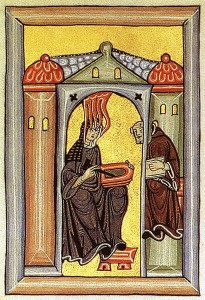By Elizabeth A. Lehfeldt (W&M Regular Contributor)

Congratulations to Hildegard of Bingen (1098-1179)! Pope Benedict XVI has announced that he will recognize her as a Doctor of the Church in October of this year. She will join the ranks of only thirty-three other individuals and she will be only the fourth woman to receive this prestigious recognition. What does this title mean and what is its significance for Hildegard of Bingen?
According to the Catholic Encyclopedia, “certain ecclesiastical writers have received this title on account of the great advantage the whole Church has derived from their doctrine.” So it wouldn’t surprise us to find the likes of St. Augustine, St. Jerome, and St. Bede the Venerable among their ranks. Considering the vast array of ecclesiastical writers and theologians that populate Catholic history, however, the list is surprisingly short and exclusive. And the previous female additions to this canon have come only in the last forty-five years: St. Teresa of Avila (1970), St. Catherine of Siena (1970), and St. Thérèse of Lisieux (1997).
Hildegard of Bingen was a visionary nun of the twelfth century. In addition to recording her visionary experiences, she wrote on a vast array of other topics, including the natural sciences and theology. In her lifetime she corresponded with popes and was sought out by other ecclesiastics for her advice. She also wrote music that has been widely performed and recorded in the modern era. Click here for a sample of from one of these recordings.
The nomination to be a Doctor of the Church must come from the papacy or an ecumenical council (although no council has ever exercised this prerogative). Thus, the decision to nominate may tell us as much about the nominee as it does about the historical context during which that recognition is achieved (an approach that has been effectively applied to the study of canonization proceedings as well).
Benedict XVI appears to have a particular affinity for Hildegard. He has spoken about her in several general audiences dating back to at least 2010. In September of that year he said “She brought a woman’s insight to the mysteries of the faith. In her many works she contemplated the mystic marriage between God and humanity accomplished in the Incarnation, as well as the spousal union of Christ and the Church. She also explored the vital relationship between God and creation, and our human calling to give glory to God by a life of holiness and virtue.” He has continued to include her in his remarks, indicating most recently his decision to elevate her to the status of Doctor.
Curiously, he will have to canonize her as a saint first, since that is required for the status of Doctor and Hildegard had only previously reached the ranks of the beatified.
Elizabeth A. Lehfeldt is Chair and Professor of History at Cleveland State University. She writes on the history of gender in premodern Europe.
